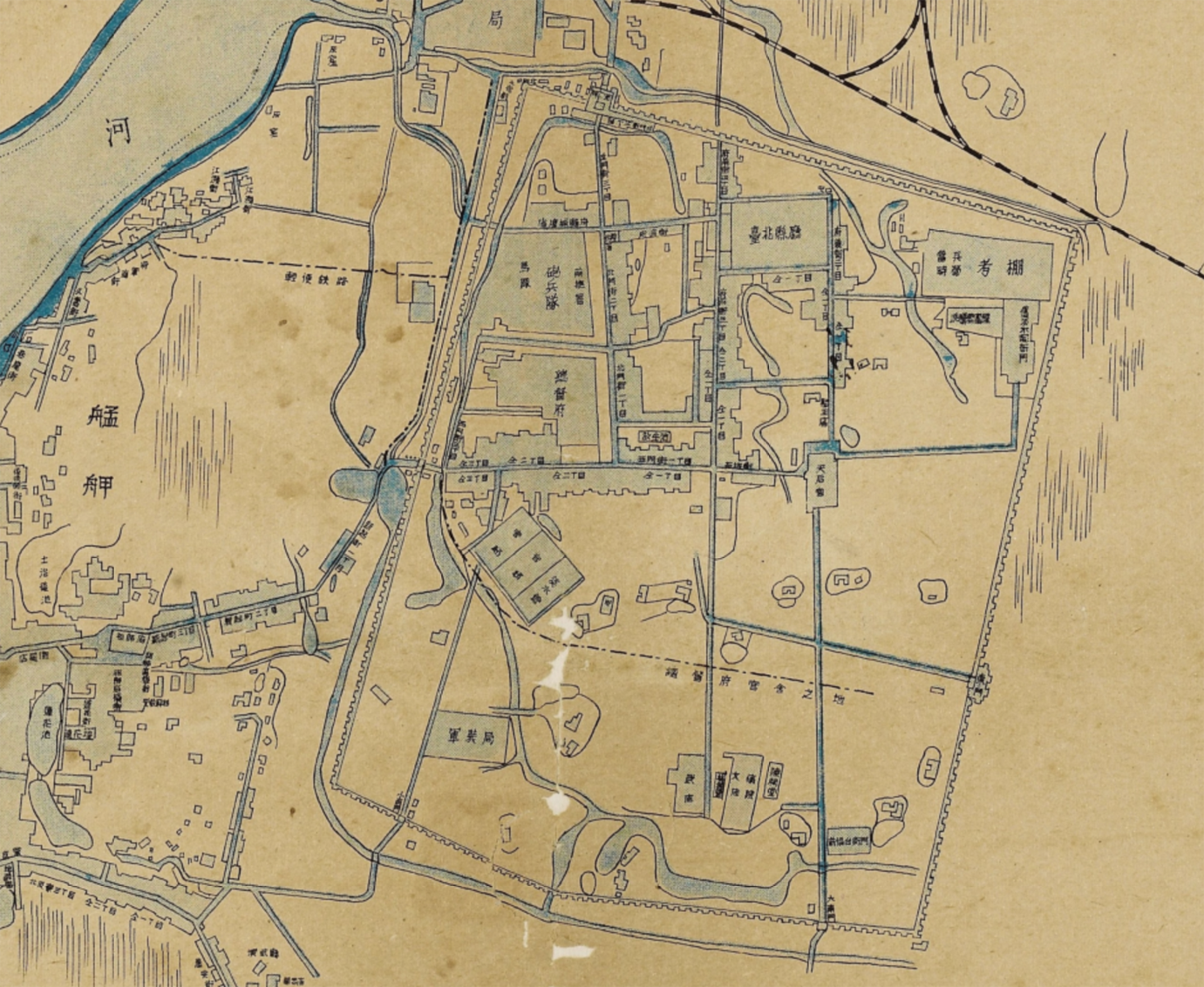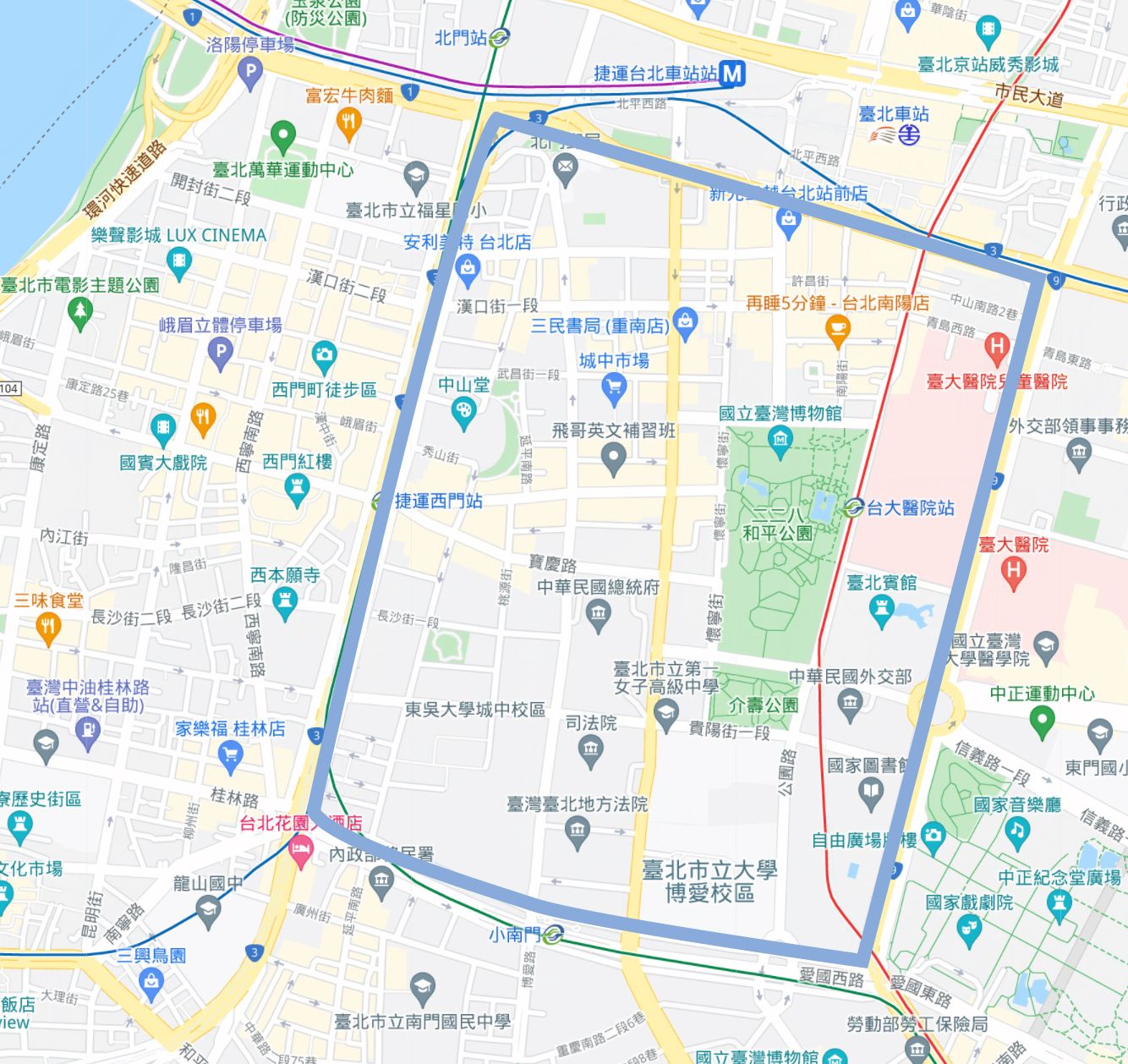
In die weiße Welt 在白色世界,對於每天猶如重新開始的起端,塑造成未來對每一個事務能嶄新的探索世界和與世界產生連結。 主要分享從藝術、設計展覽筆記,和旅遊與生活的觀察記載。 象特市不定期出沒,主發表平日練習的藝術字與草稿圖:https://liker.social/web/@yuyuhe2021
Zhonghua Shopping Center|The past appearance of Zhonghua Road
Taiwan broke out in the Sino-Japanese War between the Qing Dynasty and Japan in 1894. Due to the defeat of the Qing Dynasty, the Treaty of Shimonoseki was signed in 1895 and ceded to Japan. Then Taiwan changed from the Qing Dynasty to the Japanese governance period (also known as the period of Japanese colonial rule, the period of Japanese occupation, the period of Japanese rule, and the period of Japanese occupation), and experienced 51 years of Japanese rule.
- Japanese governance period from 1895-1945


In the early days of the Japanese occupation period (Meiji 34, and 1901 AD), the "Second Urban Revision Plan" was announced. Under the urban planning reform, the space after the demolition of the city wall of Taipei City during the Qing Dynasty was mainly used. It was rebuilt into a tree-lined avenue separated by an island into three separate roads, and it has also become the four urban trunk roads in Taipei, Taiwan. It is divided into four sections: South Zhongshan Road, Aiguo West Road, Zhonghua Road, Zhongxiao West Road, these four roads are called three lines under the design of the partition island.
For example: Zhonghua Road is located in the west and can be called the West Third Line, while the North Third Line is Zhongxiao West Road, and so on.
- The three lines were once known as the "Little Paris of the East" during the Japanese governance period.
- In the 1930s, there was a trend of free love in Taiwan, and the three lines were spots for people to date and walk at that time. For example, in the lyrics of "Moon Night Sorrow" written by Zhou Tianwang , a lyricist in Taiwanese pop music, the content describes young girls waiting for no chance on the three lines. Lover's story.
*Before the urban correction plan, because the map of Taiwan was drawn in the early Qing Dynasty to observe the Taiwan region and the mining resources mainly based on China's domestic demand, the directions of many maps were not unified due to the painter's viewing angle. During the period when the Japanese ruled Taiwan, field investigation and map drawing were used to assist future management and urban planning. In addition, under the influence of Western science and culture at that time, Japan decided that a compass should be marked on the map, and the top of the map was determined by the north. , also lists the accuracy of the scale.
- If you are interested in maps of the Japanese period, you can refer to the arrangement of the digital archives of map telemetry images.
Post-war period in Taiwan (1945-present)
Residents from all over mainland China since the late period of the Kuomintang-Communist civil war in 1949. At that time, in order to resettle the residents, the central government commissioned the Taipei City Police and Citizens Association to build three temporary bamboo huts along the east side of the railway passing through Zhonghua Road, using the space adjacent to the railway side lanes in the original three lines . Due to the messy living and large-scale illegal construction of the shack, it was once criticized as a "tumor of the city".
In 1960, in order to rectify the city appearance, the central government decided to rebuild a new shopping mall on the spot, and the shopping mall was named "China Mall" .
"Zhonghua Shopping Mall" was once the focus of life for Taipei people and people from other counties and cities visited famous attractions in Taipei.
When: Built since 1961, demolished in 1992. Location: From Zhongxiao West Road in the north to Aiguo West Road in the south.
feature
- The naming method of the eight major buildings is loyalty, filial piety, benevolence, love, faith, righteousness, harmony, and flat buildings. Among them, the floors of the second floor are connected by land bridges to form eight department stores, with a total of three floors and a total length of 1171 meters.
- The pedestrian overpass connected on the first section of Zhonghua Road leads to Wuchang, Hankou, and Kaifeng Streets running east-west and directly to the second floor. The overpass located on the second floor looks down. One side is the Longitudinal Railway from Taipei Station to Wanhua Station, and the other side is Street view of the road.
- Accommodates 1,644 tenants and signs a 20-year lease with the government, with an average of only about 2 pings of space per household; the first floor is a store, the second and third floors are homes, and the tenants on the second floor later became store owners and used the space as a small attic. Residential use.
Featured store
Zhong and Xiao Buildings: Businesses selling household appliances, audio and electronic components.
There are audio booths specializing in electronic components and domestic "homemade speakers".
After the 1960s, Wenzhong Bookstore (located at No. 13, 2nd Floor, Zhongdong Building, Zhonghua Shopping Center) began to imitate the business model of Japanese ancient bookstores. , regularly publishes its own catalogue of ancient books in handwritten mimeograph.
With the rise of the personal computer industry in the 1980s, merchants selling related software, hardware and peripherals.
Ren and Ai Buildings: Merchants selling antiques, antiques and calligraphy and painting.
In the 1970s, the focus of purchases by tourists from south-central Taiwan and Japan included jade, enamel and Taiwanese folk art, stamps, ancient coin collection and exchange shops, and fortune-telling booths and used booksellers.
Xindong: There are Columbia Records , Universal, Xinxin, MGM, and Jiajia Records on the second floor, which sells copies of Western pop songs, jazz or old Shanghai songs, as well as Songzhu , which sells classical music, as well as traditional music stores. Jinmen Records , which sells Peking Opera and local opera records, etc.
Yidong: Restaurant with snacks from all over China
The famous ones include "Xuzhou Shaguo", "Real Peiping Restaurant" with Peking duck and sauerkraut white meat pot, and "Dim Sum World" signature pot stickers with hot and sour soup.
He and Ping Buildings: mostly clothing, uniforms, jeans, military clothing, teahouses for the elderly, flag badges and other related businesses.
Pingdong: Hong Jianquan Audio-Visual Library , which has a collection of tens of thousands of classical, folk, jazz vinyl, as well as music magazines from all over the world, free for the public to borrow.
The National Opera Shoe Store was opened for Li Guoxiu's father Li Shenen, and Li Guoxiu's family also moved into the Zhonghua mall.
After 1980, under the needs of the Taipei MRT construction in the urban reconstruction plan of Taipei City, Zhonghua Road was used for the acquisition of the MRT project.
In 1978, when President Chiang Ching-kuo appointed Lee Teng-hui as the mayor of Taipei City, he implemented the " Taipei East District Urban Plan" (which includes the Xinyi Sub-city Plan ) , and promoted the Taipei City Government to move to the East District (today's Xinyi District, Taipei City), in order to cooperate with the central government. The Western District, where the government is located, also has a vision of balancing the regional development of the Taipei area.
In the process of urban evolution, many shops in Taipei moved to the East District, and the prosperity of the East District led to the decline of the West District. In recent years, the mayor of Taipei proposed the "West District Gateway Project" for Ke Wenzhe, which has transformed the current urban appearance to integrate history. Attractions, Ximending business districts, and large-scale events will be stationed in Huoluo West District, etc., to reshape the West District from the characteristics of tourism and tourism, and promote the flow of people and businessmen to leave the West District prosperous.
Like my work?
Don't forget to support or like, so I know you are with me..
Comment…